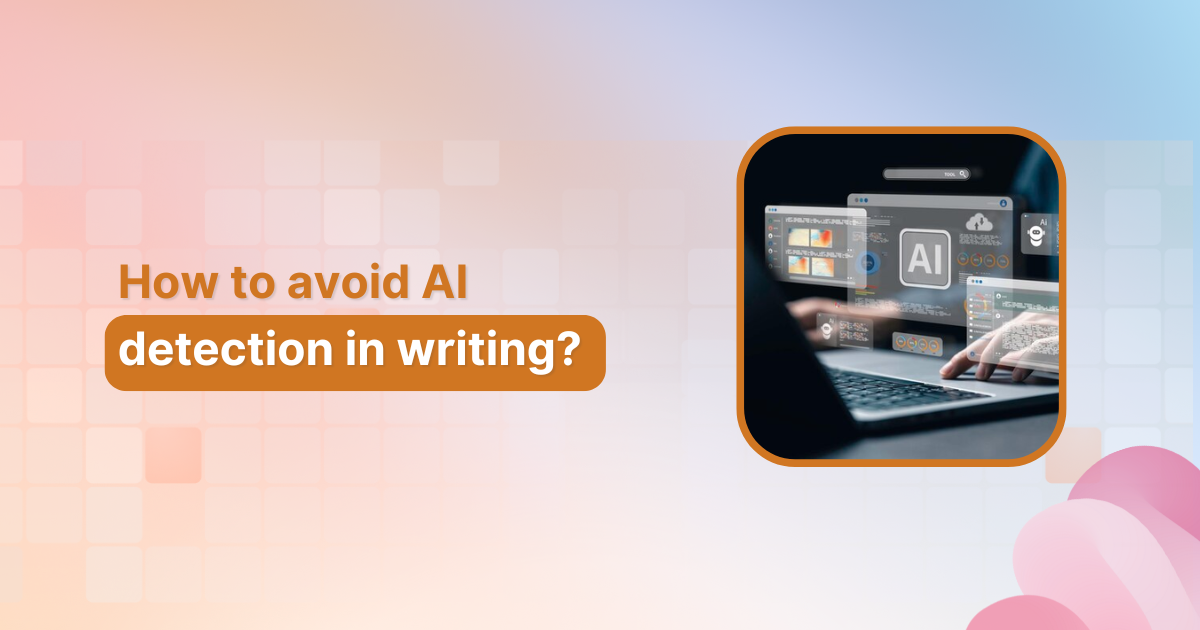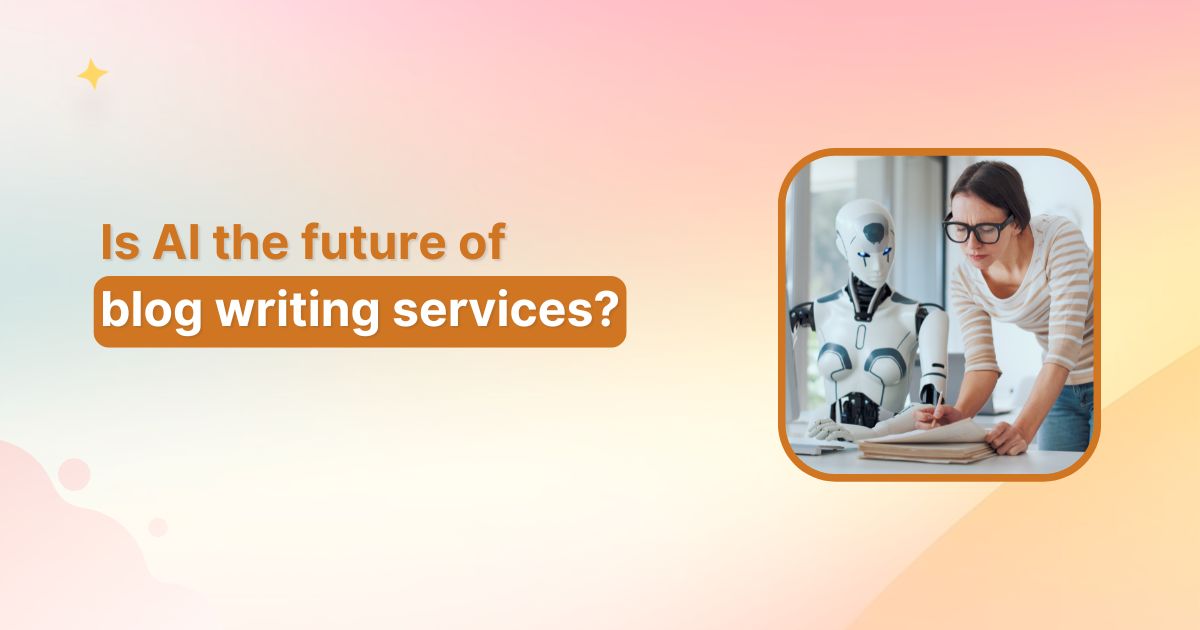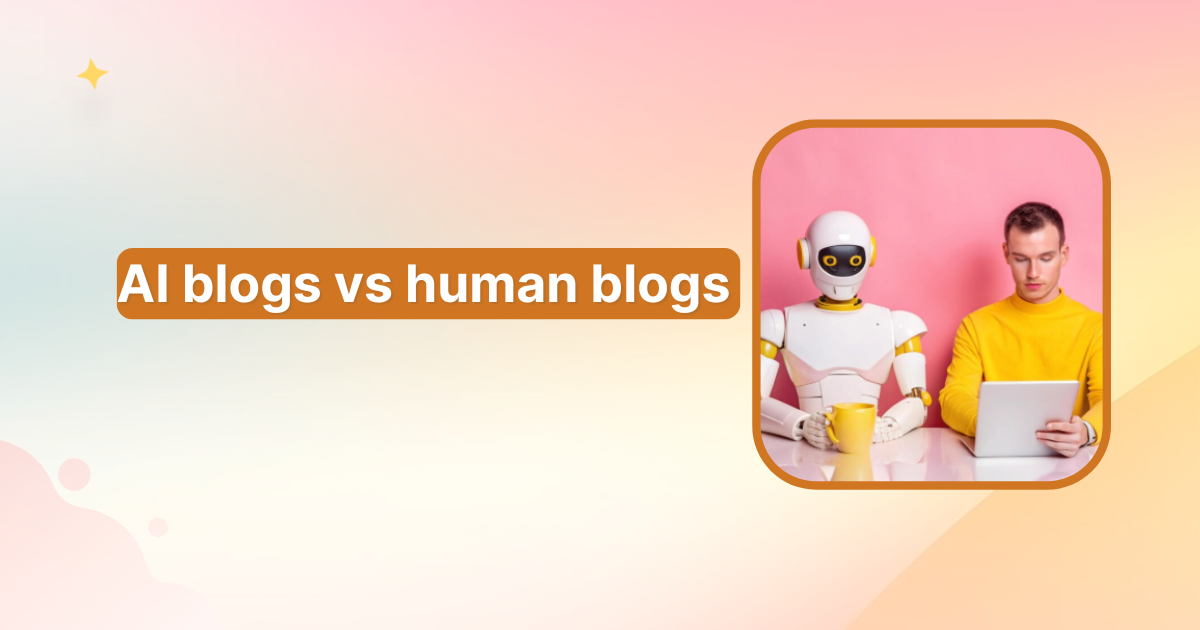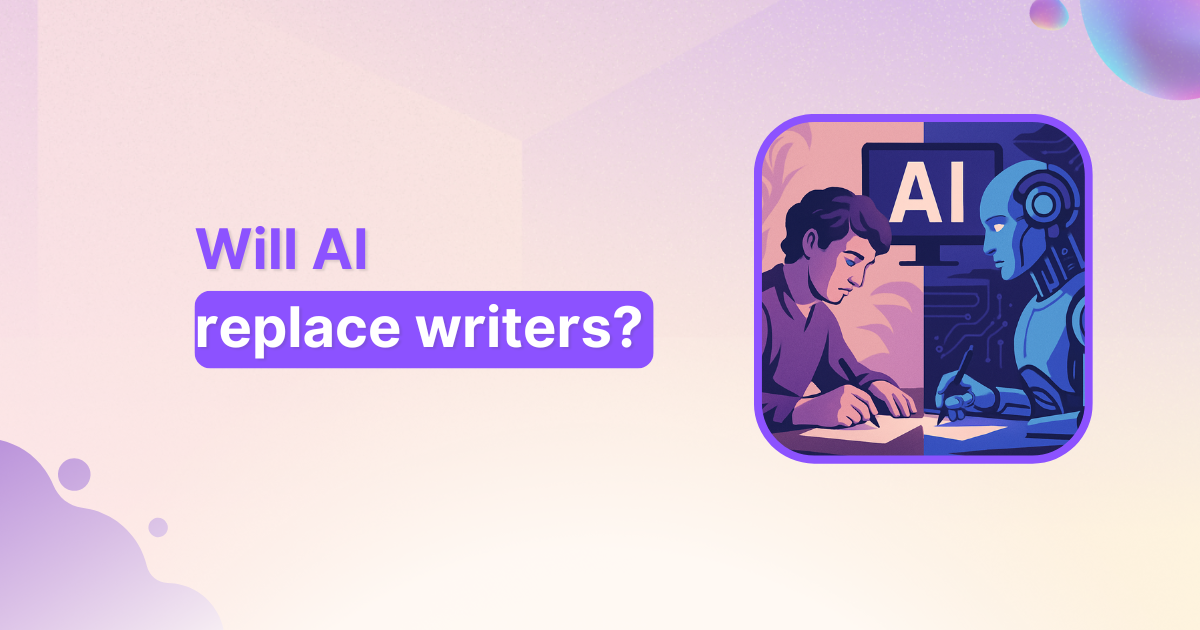How to avoid AI detection in writing: Guide to humanizing AI content

AI-generated content is everywhere now—blog posts, essays, marketing copy, social media captions, product descriptions, and even professional reports.
Tools like ChatGPT and Jasper make writing easier, but they also come with a challenge: AI detection systems are getting smarter.
If you’re a writer, student, or professional, knowing how to avoid AI detection in writing is key to keeping your work authentic.
The good news? You can humanize AI-generated content with the right techniques, making it sound natural and uniquely yours.
This guide will show you exactly how to tweak AI-written text so it feels like something only a human could create. Let’s dive in!
What is AI detection?
AI detection is the process of identifying whether a piece of content – text, images, audio, or video – has been created by artificial intelligence instead of a human.
At its core, AI detection works by comparing a given piece of content against known human-created content and identifying inconsistencies.
These inconsistencies arise because AI models generate text using probability-based predictions rather than organic thought processes.
As a result, AI-generated content often exhibits patterns that are more structured, repetitive, and predictable compared to human writing.
AI detection is widely used in various fields, including:
- Academia – To detect AI-assisted assignments and prevent academic dishonesty.
- Publishing & journalism – To ensure articles are written by humans and maintain editorial integrity.
- Marketing & SEO – To assess content originality and authenticity for search engines and readers.
- Legal & compliance – To verify authorship and ensure transparency in official documents.
How does AI detection work?
AI detection algorithms examine multiple characteristics of a text to determine whether it was likely generated by an AI. These include:
| Characteristics | Description |
| Statistical analysis | AI-generated text often follows predictable structures and word choices, distinguishing it from human writing. |
| Perplexity & burstiness | Human writing has natural variations in sentence length and complexity, whereas AI text is more uniform and structured. |
| Linguistic cues | AI-generated content lacks emotional depth, inconsistencies, and contextual adaptability, common in human writing. |
| Metadata & hidden markers | Some AI-generated text includes invisible markers or metadata that indicate AI authorship, making detection easier. |
By analyzing these elements, AI detection models can identify AI-generated content with increasing accuracy.
Strategies to avoid AI detection in writing
To effectively avoid AI detection, it’s important to understand how AI-generated content is identified. AI detection tools analyze patterns, sentence structures, and predictability in writing.
1. Humanize the text
One of the most effective ways to avoid AI detection is to humanize the text. This involves making the content sound more natural and less robotic. Here are some tips to achieve this:
- Vary sentence structure: AI-generated content often has a uniform sentence structure. Mix short and long sentences to create a more natural flow. This mimics human writing patterns and reduces predictability.
- Use idioms and colloquialisms: Incorporate idiomatic expressions and colloquial language that are less likely to be used by AI. Phrases like “a blessing in disguise” or “hit the nail on the head” add a conversational tone.
- Add personal anecdotes: Including personal stories or experiences can make the content feel more authentic and human. A brief personal insight or a relatable scenario enhances engagement.
- Use active voice: AI-generated content often relies on passive voice. Switching to active voice can make the text more engaging and human-like. For example, “The team completed the project” sounds more natural than “The project was completed by the team.”
- Introduce emotion: Adding emotional elements such as humor, excitement, or empathy makes the content feel more personal and human-written.
2. Edit and revise
Editing is crucial when it comes to avoiding AI detection. Even the best AI-generated content can benefit from a human touch. Here’s how to edit effectively:
- Rephrase sentences: Rewrite sentences to make them less predictable and more unique. Avoid formulaic structures that AI tends to follow.
- Add nuance: Introduce subtle nuances and variations in tone that are difficult for AI to replicate. This could include rhetorical questions or varied pacing in writing.
- Check for consistency: Ensure that the content is consistent in style and tone throughout. Inconsistencies can be a red flag for AI detection tools.
- Read aloud: Reading the content aloud can help identify unnatural phrasing and robotic patterns.
- Use a second pair of eyes: Having someone else review the content can help pinpoint areas that sound overly mechanical or structured.
3. Use AI writing tools wisely
While AI writing tools are incredibly useful, they should be used as a starting point rather than the final product. Here’s how to use them wisely:
- Combine multiple tools: Different AI writing tools are used to generate content, and then the outputs are blended to create a more diverse and less detectable text.
- Customize outputs: Most AI tools allow you to customize the output by adjusting parameters like tone, style, and complexity. Experiment with these settings to produce more human-like content.
- Avoid over-reliance: Don’t rely solely on AI-generated content. Use it as a foundation and build upon it with your own insights and creativity.
- Infuse unique perspectives: AI-generated content often lacks originality. Adding fresh viewpoints, unique examples, and personal insights can enhance authenticity.
4. Incorporate human elements
Adding human elements to your content can significantly reduce the chances of it being flagged as AI-generated.
Here’s how to do it:
- Include opinions and perspectives: Share your own opinions, perspectives, and insights to make the content more personal and less generic.
- Use real-world examples: Incorporate real-world examples and case studies that are relevant to the topic. This adds depth and authenticity to the content.
- Engage with the audience: Write in a conversational tone and engage with the reader by asking questions or encouraging them to think critically.
- Break the rules occasionally: AI tends to follow strict grammatical rules. Humans, on the other hand, sometimes break grammar conventions for emphasis or effect, making writing feel more natural.
5. Leverage paraphrasing tools
Paraphrasing tools can be a valuable asset in avoiding AI detection. These tools can help you rephrase AI-generated content to make it less detectable.
Here’s how to use them effectively:
- Choose the right tool: Select a paraphrasing tool that offers advanced options for rephrasing, such as changing sentence structure and word choice.
- Rephrase strategically: Focus on rephrasing key sections of the content, especially those that are more likely to be flagged by AI detection tools.
- Review the output: Always review the paraphrased content to ensure it maintains the original meaning and flows naturally.
- Manually adjust where needed: Automated paraphrasing may sometimes produce awkward phrasing. Tweaking the output manually enhances readability.
6. Use plagiarism checkers
Plagiarism checkers can help you identify and eliminate any content that may be flagged as AI-generated.
Here’s how to use them:
- Run a plagiarism check: Use a plagiarism checker to scan your content for any similarities with existing AI-generated text.
- Make necessary adjustments: If the plagiarism checker flags any content, make the necessary adjustments to ensure it’s unique and original.
- Cross-check with AI detection tools: After making adjustments, cross-check the content with AI detection tools to ensure it’s no longer detectable.
- Rewrite high-risk sections: AI-generated content often appears similar across different pieces. Identifying and reworking these sections enhances uniqueness.
7. Focus on quality and depth
High-quality, in-depth content is less likely to be flagged as AI-generated.
Here’s how to achieve this:
- Research thoroughly: Conduct thorough research on the topic to ensure your content is accurate and well-informed.
- Provide detailed insights: Offer detailed insights, analysis, and explanations that go beyond surface-level information.
- Use credible sources: Cite credible sources and references to add authority and credibility to your content.
- Avoid generic content: AI-generated text often lacks depth. Adding substantial analysis and expert opinions improves authenticity.
8. Experiment with different writing styles
Experimenting with different writing styles can help you create content that is less predictable and more human-like.
Here’s how to do it:
- Try different tones: Experiment with different tones, such as formal, informal, persuasive, or informative, to see which one works best for your content.
- Mix writing styles: Combine different writing styles, such as narrative, descriptive, and expository, to create a more diverse and engaging piece.
- Adapt to the audience: Tailor your writing style to the target audience, taking into account their preferences, interests, and level of expertise.
- Switch perspectives: Writing in first-person, second-person, or third-person voice can create variation and make the content less robotic.
9. Use AI detection tools to your advantage
Ironically, AI detection tools can be used to your advantage when trying to avoid AI detection.
Here’s how:
- Test your content: Run your content through AI detection tools to see if it gets flagged. Use the feedback to make necessary adjustments.
- Analyze the results: Analyze the results from the AI detection tools to identify patterns or characteristics that may be giving away the AI-generated nature of your content.
- Iterate and improve: Continuously iterate and improve your content based on the feedback from AI detection tools until it passes as human-written.
- Identify common AI pitfalls: Understanding what triggers AI detection helps refine content accordingly.
10. Stay updated on AI detection trends
AI detection technology is constantly evolving, so it’s essential to stay updated on the latest trends and developments.
Here’s how:
- Follow industry news: Keep an eye on industry news and updates related to AI detection technology.
- Join online communities: Join online communities and forums where professionals discuss AI detection and share tips and strategies.
- Experiment with new tools: Experiment with new AI writing and detection tools to stay ahead of the curve and adapt your strategies accordingly.
- Monitor detection algorithms: Understanding how AI detection tools evolve can help you refine your approach continuously.
By implementing these strategies, you can create content that appears more organic, engaging, and human-like. Avoiding AI detection isn’t just about tricking algorithms; it’s about producing high-quality, authentic writing that resonates with readers.
As AI detection tools evolve, staying adaptable and refining your approach will help maintain the natural flow and originality of your content.
Ethical considerations in AI-generated content
While knowing how to avoid AI detection is useful, it’s equally important to consider the ethical implications of AI-generated content.
Misuse can lead to trust issues, legal concerns, and reputational damage. Here are key ethical considerations to keep in mind:
1. Transparency: Disclose AI usage
Being transparent about AI-generated content helps maintain trust with your audience. If AI is used to assist in content creation, consider disclosing it. For example:
- Ethical approach: “This article was created with AI assistance and edited by a human for accuracy.”
- Unethical approach: Passing off AI-generated content as entirely human-written without any modifications.
2. Originality: Avoid plagiarism
AI tools should be used to enhance creativity, not replace it. Always ensure your content is original and not copied from other sources. Ways to maintain originality include:
- Paraphrasing thoughtfully: Instead of copy-pasting AI outputs, rewrite them in your own words.
- Adding unique insights: Infuse personal experiences, opinions, or industry-specific expertise.
- Using plagiarism checkers: Tools like Copyscape or Grammarly can help ensure content remains unique.
3. Quality: Prioritize value over automation
AI-generated content should not compromise quality. Instead of mass-producing low-quality articles, focus on creating high-value content that benefits the reader. Consider:
- Fact-checking AI outputs: Verify AI-generated data to prevent misinformation.
- Enhancing readability: Edit AI-generated text to improve clarity and engagement.
- Avoiding keyword stuffing: AI may overuse keywords for SEO, but natural integration improves readability and ranking.
4. Compliance: Follow legal and ethical guidelines
AI content should align with ethical and legal standards to prevent misleading or deceptive practices. Ensure:
- Adherence to regulations: Content should comply with copyright laws and data privacy regulations like GDPR.
- Avoiding manipulation: AI should not be used to create false narratives, deepfakes, or misleading product claims.
- Respect for cultural sensitivities: AI might lack cultural awareness, so reviewing content for appropriateness is crucial.
By considering these ethical guidelines, you can use AI content writer responsibly while maintaining credibility and trust with your audience.
Conclusion
As AI technology continues to evolve, staying updated on the latest trends and developments is crucial. By following the strategies outlined in this guide and considering the ethical implications, you can create high-quality, undetectable content that resonates with your audience and stands the test of time.
Remember, the goal is not to deceive but to enhance your writing with the help of AI while maintaining authenticity and originality. With the right approach, you can harness the power of AI to create compelling, human-like content that avoids detection and delivers value to your readers.
FAQs on AI-generated content
To make AI-generated content more original:
– Add your own insights, opinions, and expertise.
– Conduct additional research to include unique data or examples.
– Blend content from multiple AI tools to create a diverse output.
– Use plagiarism checkers to ensure the content is unique.
To stay updated on AI detection trends:
– Follow industry blogs and news outlets covering AI and content creation.
– Join online communities or forums focused on AI writing tools and detection.
– Experiment with new AI writing and detection tools as they are released.
– Attend webinars or conferences on AI and content creation.
The ethics of using AI-generated content depends on the context. In most cases, it’s best to be transparent about using AI tools, especially in academic or professional settings. However, using AI as a tool (without misrepresentation) is generally acceptable if the goal is to enhance creativity and productivity.
Yes, AI-generated content can rank well on search engines if it is high-quality, original, and optimized for SEO. However, search engines like Google prioritize content that demonstrates expertise, authoritativeness, and trustworthiness (E-A-T), so human input is often necessary to achieve these qualities.
If your content is flagged as AI-generated:
– Review the flagged sections and rephrase them to sound more human-like.
– Add personal insights, examples, or anecdotes to enhance authenticity.
– Test the revised content using AI detection tools to ensure it passes.
You might be interested in...

Is AI the future of blog writing services?
Traditional blog writing services face their biggest disruption yet. With generative AI tools producing content in seconds, businesses are questioning whether they still need human writers. AI writing tools have transformed from niche curiosities to mainstream business solutions practically overnight. Content agencies report a common refrain from clients: “Why should we pay for human writers […]
Aug 5, 2025

AI blogs vs human blogs: Which creates better content in 2025?
The debate between AI blogs vs human blogs has reached a tipping point. With AI tools for content creation becoming more popular and advanced, businesses are questioning whether they should stick with human writers or embrace artificial intelligence for their content strategy. Studies indicate that 88% of marketers are already relying on AI to handle […]
Jul 14, 2025

Will AI replace writers? The truth behind the hype
The digital landscape is buzzing with excitement and anxiety about AI writing tools. From Contentpen’s intelligent content generation to ChatGPT’s conversational prowess and Jasper’s marketing copy expertise, artificial intelligence has stormed into the writing world with impressive capabilities. This technological leap forward has sparked a burning question that keeps writers awake at night: Will AI […]
Jun 19, 2025